Easy-to-Print PLA 3D Printer Filaments
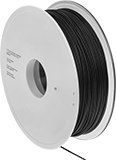
The most commonly used 3D printing material, these PLA filaments make detailed parts at a low melting point, so they won’t warp as they cool, rarely clog nozzles, and don’t require a heated printer bed. They’re also unlikely to drip and produce plastic strings for a clean finished part. In general, they’re best for printing prototypes instead of load-bearing parts since they’re not as strong as ABS or as heat resistant as PEEK. Print them on a fused filament fabrication (FFF) 3D printer.
Wood-like PLA filaments mimic wood without actual wood powder, and exhibit similar density and appearance to wood. You can sand, paint, and stain your part.
Tensile strength is the best measure of a filament’s overall strength. Similar to the stress applied on a rope during a game of tug-of-war, it’s the amount of pulling force a material can handle before breaking. A higher rating means a stronger filament. A tensile strength of 5,000 psi and above is considered good; 12,000 psi and above is excellent.
Maximum exposure temperature is the point at which a printed part will begin to deform. Above this temperature, your part will start to lose structural integrity.
Spool | ||||||||||
|---|---|---|---|---|---|---|---|---|---|---|
| Dia., mm | Printing Temp. | For Printer Bed Temp. | Tensile Strength | Max. Exposure Temp. | For Min. Nozzle Dia., mm | Dia., mm | Dp., mm | Wt., g | Each | |
Wood-Like PLA Plastic | ||||||||||
Opaque Beige | ||||||||||
| 1.75 | 190° to 210° C 374° to 410° F | 30° to 50° C 86° to 122° F | 3,490 psi (Poor) | 58° C 136° F | 0.4 | 200 | 51 | 600 | 00000000 | 000000 |
| 2.85 | 190° to 210° C 374° to 410° F | 30° to 50° C 86° to 122° F | 3,490 psi (Poor) | 58° C 136° F | 0.4 | 200 | 51 | 600 | 00000000 | 00000 |
UV-Indicating Easy-to-Print PLA 3D Printer Filaments
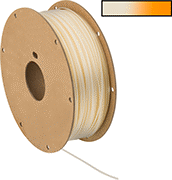
Often used to monitor UV exposure and test UV curing and sterilization equipment, parts made from these filaments change color when exposed to the sun or UV lights. Made from PLA, the most commonly used 3D printing material, they make detailed parts at a low melting point. As a result, they rarely clog nozzles, won’t warp as they cool, and don’t require a heated printer bed. They’re also unlikely to drip and produce plastic strings for a clean finished part. Print them on a fused filament fabrication (FFF) 3D printer.
Tensile strength is the best measure of a filament’s overall strength. Similar to the stress applied on a rope during a game of tug-of-war, it’s the amount of pulling force a material can handle before breaking. A higher rating means a stronger filament. A tensile strength of 5,000 psi and above is considered good; 12,000 psi and above is excellent.
Maximum exposure temperature is the point at which a printed part will begin to deform. Above this temperature, your part will start to lose structural integrity.
Spool | ||||||||||
|---|---|---|---|---|---|---|---|---|---|---|
| Dia., mm | Printing Temp. | For Printer Bed Temp. | Tensile Strength, psi | Max. Exposure Temp. | For Min. Nozzle Dia., mm | Dia., mm | Dp., mm | Wt., g | Each | |
PLA Plastic | ||||||||||
Beige to Orange Indicator | ||||||||||
| 1.75 | 190° to 230° C 374° to 446° F | 25° to 60° C 77° to 140° F | 6,620 (Good) | 58° C 136° F | 0.4 | 200 | 65 | 1,000 | 0000000 | 000000 |
Impact-Resistant ABS 3D Printer Filaments
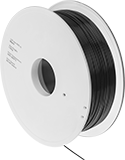
Bumps, scrapes, and falls won’t damage these tough ABS filaments. Known for their durability, they absorb impact without cracking or breaking, and won’t degrade when heated. Use them to print tool handles, storage cases, and other parts that are handled or dropped frequently. These filaments are a good place to start if you’re experimenting with printing impact-resistant parts.
Use with a fused filament fabrication (FFF) 3D printer. These filaments have a high melting point and must be printed onto a heated bed. Without it, parts will cool too quickly and warp. These filaments also release fumes as they are printed, so use an enclosed printer or a fume exhauster to ventilate them.
Tensile strength is the best measure of a filament's overall strength. Similar to the stress applied on a rope during a game of tug-of-war, it's the amount of pulling force a material can handle before breaking. A higher rating means a stronger filament. A tensile strength of 5,000 psi and above is considered good; 12,000 psi and above is excellent.
Maximum exposure temperature is the point at which a printed part will begin to deform. Above this temperature, your printed parts will start to lose structural integrity.
Spool | |||||||||||
|---|---|---|---|---|---|---|---|---|---|---|---|
| Dia., mm | Printing Temp. | For Printer Bed Temp. | Tensile Strength | Max. Exposure Temp. | For Min. Nozzle Dia., mm | Dia., mm | Dp., mm | Wt., g | Color | Each | |
ABS Plastic | |||||||||||
| 1.75 | 220° to 240° C 428° to 464° F | 100° to 110° C 212° to 230° F | 6,090 psi (Good) | 90° C 194° F | 0.25 | 195 | 75 | 1,000 | Beige | 00000000 | 000000 |
Slippery Wear-Resistant 3D Printer Filaments

Often used to make bearings, worm gears, and other smooth moving parts, these filaments create parts that won’t wear out from constant motion. They're a slippery thermoplastic blend, so they have better wear resistance and lower friction than other filaments.
Print these filaments on a fused filament fabrication (FFF) printer. Because of their high melting point, a heated printer bed is recommended since the parts will cool too quickly and warp without it. You must use an enclosed printer or fume exhauster while printing these filaments. Store them in a sealed container with a desiccant, or use a dehumidifying cabinet, since moisture in the air can degrade their printing quality.
Maximum exposure temperature is the point at which a printed part will begin to deform. Above this temperature, your printed parts will start to lose structural integrity.
Spool | |||||||||||
|---|---|---|---|---|---|---|---|---|---|---|---|
| Dia., mm | Printing Temp. | For Printer Bed Temp. | Tensile Strength | Hardness | Max. Exposure Temp. | For Min. Nozzle Opening Dia., mm | Dia., mm | Dp., mm | Wt., g | Each | |
Thermoplastic Blend | |||||||||||
Beige | |||||||||||
| 1.75 | 260° to 280° C 500° to 536° F | 100° to 130° C 212° to 266° F | Not Rated | Durometer 66D (Medium) | 120° C 248° F | 0.4 | 205 | 70 | 750 | 000000 | 0000000 |
| 2.85 | 260° to 280° C 500° to 536° F | 100° to 130° C 212° to 266° F | Not Rated | Durometer 66D (Medium) | 120° C 248° F | 0.4 | 205 | 70 | 750 | 0000000 | 000000 |
Ultra-Strength High-Temperature PAEK 3D Printer Filaments
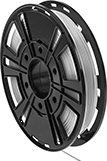
Parts made from these PAEK filaments, a family of materials that includes PEEK and PEKK, remain strong in high temperatures and hold up to wear from repeated use. They don’t degrade when exposed to most chemicals, so they’re often used to print parts for demanding chemical processing applications. Print these filaments on a fused filament fabrication (FFF) 3D printer. Because of their high melting point, you'll need an all-metal extruder and heated printer bed to reach their minimum printing temperature. Without the heated printer bed, parts will cool too quickly and warp.
Fiberglass-filled PEEK filaments make stronger parts that are less likely to warp and shrink than unfilled PEEK filaments. Since they’re abrasive, you should only use them with an abrasion-resistant nozzle.
Tensile strength is the best measure of a filament's overall strength. Similar to the stress applied on a rope during a game of tug-of-war, it's the amount of pulling force a material can handle before breaking. A higher rating means a stronger filament. A tensile strength of 5,000 psi and above is considered good; 12,000 psi and above is excellent.
Maximum exposure temperature is the point at which a printed part will begin to deform. Above this temperature, your printed parts will start to lose structural integrity.
Annealing is the process of heating prints to a specific annealing temperature and then slowly allowing them to cool. This makes the finished print harder, stronger, and better at resisting heat. Maximum temperature after annealing replaces the maximum exposure temperature once this process has been completed.
Spool | |||||||||||||
|---|---|---|---|---|---|---|---|---|---|---|---|---|---|
| Dia., mm | Printing Temp. | For Printer Bed Temp. | Tensile Strength | Max. Exposure Temp. | Max. Annealing Temp. | Max. Temp. After Annealing | For Min. Nozzle Dia., mm | Dia., mm | Dp., mm | Wt., g | Color | Each | |
PEEK Plastic | |||||||||||||
| 1.75 | 375° to 410° C 707° to 770° F | 130° to 145° C 266° to 293° F | 14,500 psi (Excellent) | 140° C 284° F | 140° C 284° F | 230° C 446° F | 0.4 | 195 | 40 | 500 | Opaque Beige | 0000000 | 0000000 |
Fiberglass-Filled PEEK Plastic | |||||||||||||
| 1.75 | 375° to 410° C 707° to 770° F | 130° to 145° C 266° to 293° F | 13,050 psi (Excellent) | 260° C 500° F | 140° C 284° F | 315° C 599° F | 0.4 | 195 | 40 | 500 | Opaque Beige | 0000000 | 000000 |
Steam-Resistant High-Temperature PSU 3D Printer Filaments

Sterilize your printed parts without them expanding, deforming, or weakening. These PSU filaments resist steam and heat, so you can sterilize parts in an autoclave. They also can be sterilized with ethylene oxide, radiation, plasma, dry heat, and cold sterilization methods. Print these filaments on a fused filament fabrication (FFF) 3D printer. Because of their high melting points, you'll need an all-metal extruder and heated printer bed to reach their minimum printing temperature. Without the heated printer bed, parts will cool too quickly and warp.
Tensile strength is the best measure of a filament’s overall strength. Similar to the stress applied on a rope during a game of tug-of-war, it’s the amount of pulling force a material can handle before breaking. A higher rating means a stronger filament. A tensile strength of 5,000 psi and above is considered good; 12,000 psi and above is excellent.
Maximum exposure temperature is the point at which a printed part will begin to deform. Above this temperature, your part will start to lose structural integrity.
Spool | |||||||||||
|---|---|---|---|---|---|---|---|---|---|---|---|
| Dia., mm | Printing Temp. | For Printer Bed Temp. | Tensile Strength | Max. Exposure Temp. | For Min. Nozzle Dia., mm | Dia., mm | Dp., mm | Wt., g | Color | Each | |
PSU Plastic | |||||||||||
| 1.75 | 350° to 380° C 662° to 716° F | 140° to 160° C 284° to 320° F | 10,730 psi (Good) | 172° C 342° F | 0.4 | 198 | 42 | 500 | Semi-Clear Beige | 0000000 | 000000 |
High-Temperature PEI 3D Printer Filaments

Often used to make parts that will be used near ovens, engines, and other hot machinery, these PEI filaments remain strong and rigid in temperatures that would soften most plastic. They’re a lightweight alternative to machined metal parts. Print these filaments on a fused filament fabrication (FFF) 3D printer. Because of their high melting points, you'll need an all-metal extruder and heated printer bed to reach their minimum printing temperature. Without the heated printer bed, parts will cool too quickly and warp.
Tensile strength is the best measure of a filament’s overall strength. Similar to the stress applied on a rope during a game of tug-of-war, it’s the amount of pulling force a material can handle before breaking. A higher rating means a stronger filament. A tensile strength of 5,000 psi and above is considered good; 12,000 psi and above is excellent.
Maximum exposure temperature is the point at which a printed part will begin to deform. Above this temperature, your part will start to lose structural integrity.
Spool | |||||||||||
|---|---|---|---|---|---|---|---|---|---|---|---|
| Dia., mm | Printing Temp. | For Printer Bed Temp. | Tensile Strength | Max. Exposure Temp. | For Min. Nozzle Dia., mm | Dia., mm | Dp., mm | Wt., g | Color | Each | |
PEI Plastic | |||||||||||
| 1.75 | 350° to 380° C 662° to 716° F | 140° to 160° C 284° to 320° F | 7,830 psi (Good) | 158° C 316° F | 0.4 | 195 | 40 | 500 | Semi-Clear Beige | 0000000 | 0000000 |
Foam-Forming Flexible 3D Printer Filaments
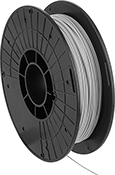
Create soft, stretchy parts that are lightweight and foam-like, letting air and gas pass through yet repelling water. These filaments are a TPE blend with a filler that dissolves in water, forming hollow spaces that make up to 45% of the part.
These filaments work with fused filament fabrication (FFF) 3D printers. If using a glass print surface, apply an adhesive to prevent the filament from detaching. The recommended print speed is 25 mm/s. Submerge your part in hot water for about 24 hours after printing to dissolve the filler and expose the pores.
For extra support when printing complex designs, use structural support 3D printer filaments. They dissolve in water at the same time as the filler in these filaments.
Tensile strength is the best measure of a filament’s overall strength. Similar to the stress applied on a rope during a game of tug-of-war, it’s the amount of pulling force a material can handle before breaking. A higher rating means a stronger filament. A tensile strength of 5,000 psi and above is considered good; 12,000 psi and above is excellent.
Maximum exposure temperature is the point at which a printed part will begin to deform. Above this temperature, your part will start to lose structural integrity.
Spool | |||||||||||||
|---|---|---|---|---|---|---|---|---|---|---|---|---|---|
| Dia., mm | Printing Temp. | For Printer Bed Temp. | Tensile Strength | Hardness | Max. Exposure Temp. | For Min. Nozzle Opening Dia., mm | Dia., mm | Dp., mm | Material | Wt., g | Color | Each | |
TPE Blend | |||||||||||||
| 1.75 | 220° to 250° C 428° to 482° F | 50° to 70° C 122° to 158° F | 150 psi | Durometer 91A (Medium Soft) | 49° C 120° F | 0.4 | 200 | 55 | Plastic | 500 | Beige | 0000000 | 000000 |
| 2.85 | 220° to 250° C 428° to 482° F | 50° to 70° C 122° to 158° F | 150 psi | Durometer 91A (Medium Soft) | 49° C 120° F | 0.4 | 200 | 55 | Plastic | 500 | Beige | 0000000 | 00000 |



























